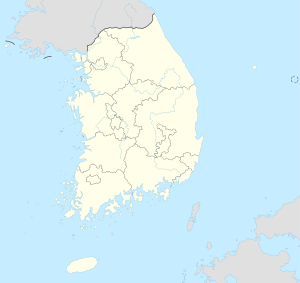Boryeong power station
| Boryeong power station | |||
|---|---|---|---|
| location | |||
|
|
|||
| Coordinates | 36 ° 24 '7 " N , 126 ° 29' 24" E | ||
| country |
|
||
| Waters | Yellow Sea (cooling with sea water) | ||
| Data | |||
| Type | Thermal power plant | ||
| Primary energy | Fossil energy | ||
| fuel | Coal , natural gas | ||
| power | 6 GW | ||
| owner | Korea Electric Power Corporation (KEPCO) | ||
| operator | Korea Midland Power | ||
| Start of operations | 1983 | ||
The Boryeong (or Poryong ) power plant is a coal and combined cycle power plant in Chungcheongnam-do Province , South Korea , located on the Yellow Sea , approx. 5 km west of the city of Boryeong . The power plant is owned by Korea Electric Power Corporation (KEPCO) but operated by Korea Midland Power .
With an installed capacity of currently 6 GW (as of February 2019), it is one of the most powerful power plants in South Korea.
Power plant units
The power plant currently consists of 2 plants, a coal-fired power plant with 8 units and a combined cycle power plant with 4 units. The following tables provide an overview:
coal-fired power station
| block | Max. Power (MW) | Start of operation | turbine | generator | Steam boiler |
|---|---|---|---|---|---|
| 1 | 500 | 12.1983 | Doosan | ||
| 2 | 500 | 09.1984 | Doosan | ||
| 3 | 500 | 04.1993 | Doosan | ||
| 4th | 500 | 06.1993 | Doosan | ||
| 5 | 500 | 12.1993 | Doosan | ||
| 6th | 500 | 04.1994 | Doosan | ||
| 7th | 500 | 12/2008 | Doosan | Doosan | Doosan |
| 8th | 500 | 12/2008 | Doosan | Doosan | Doosan |
Unit 3 of the power plant was the first power plant to achieve this record with 3000 days of trouble-free operation (December 17, 1998 to October 26, 2007). By 2012 this record could be extended to 4500 days; on September 1, 2013, the 5000 day mark was reached. Units 1 and 2 are to be shut down by the end of 2025.
Combined cycle power plant
| block | T | Max. Power (MW) | Start of operation | turbine | generator | Steam boiler |
|---|---|---|---|---|---|---|
| 1 | GT | 160 | 1997 | FIG | FIG | Doosan |
| GT | 160 | 1997 | FIG | FIG | Doosan | |
| DT | 180 | 2000 | FIG | FIG | ||
| 2 | GT | 160 | 1997 | FIG | FIG | Doosan |
| GT | 160 | 1997 | FIG | FIG | Doosan | |
| DT | 180 | 2000 | FIG | FIG | ||
| 3 | GT | 160 | 1997 | FIG | FIG | Doosan |
| GT | 160 | 1997 | FIG | FIG | Doosan | |
| DT | 180 | 2000 | FIG | FIG | ||
| 4th | GT | 160 | 1997 | FIG | FIG | Doosan |
| GT | 160 | 1997 | FIG | FIG | Doosan | |
| DT | 180 | 2000 | FIG | FIG |
The combined cycle power plant consists of four blocks, each with two gas turbines and a downstream steam turbine . A waste heat steam generator is connected to each of the two gas turbines ; the waste heat steam generator then supplies the steam turbine. The installed capacity of one block is 500 MW. The efficiency of the power plant is given as 58%. According to KEPCO, the maximum output of a block is 450 MW.
Others
In 2007, the English newspaper The Telegraph ranked Poryong in second place among the 25 largest CO 2 emitters worldwide with 37.8 million t .
See also
Individual evidence
- ↑ a b Poryong (Boryeong) Coal Power Plant South Korea. Global Energy Observatory, accessed February 13, 2019 .
- ↑ a b c Poryong (Boryeong) CCGT Power Plant South Korea. Global Energy Observatory, accessed February 13, 2019 .
- ^ Boryeong Thermal Power Complex, Boryeong-Si, Chungcheongnam-do Province, South Korea. www.powermag.com, October 15, 2008, accessed on February 13, 2019 (English).
- ↑ Breaking records in power generation. ABB , April 24, 2012, accessed February 13, 2019 .
- ↑ Boryeong Thermal Power Plant Unit 3 Records 5,000 Accident-Free Days. www.businesskorea.co.kr, September 2, 2013, accessed February 26, 2019 .
- ↑ To reduce fine dust, rickety old coal-fired power plants to go offline for one month. english.hani.co.kr, May 31, 2017, accessed on February 24, 2019 .
- ↑ Poryong Combined Cycle Power Plant, South Korea. Power Technology, accessed February 13, 2019 .
- ↑ Completion Ceremony for Poryong Thermal Power Plant Units 7 & 8. Korea Electric Power Corporation (KEPCO), June 19, 2009, accessed February 26, 2019 .
- ↑ 25 dirtiest power stations in the world. The Telegraph , November 14, 2007, accessed February 26, 2019 .
